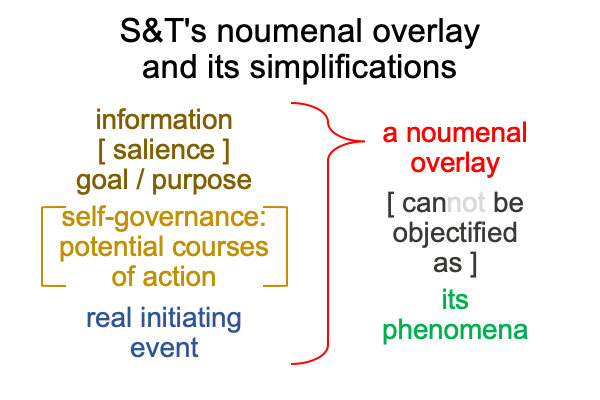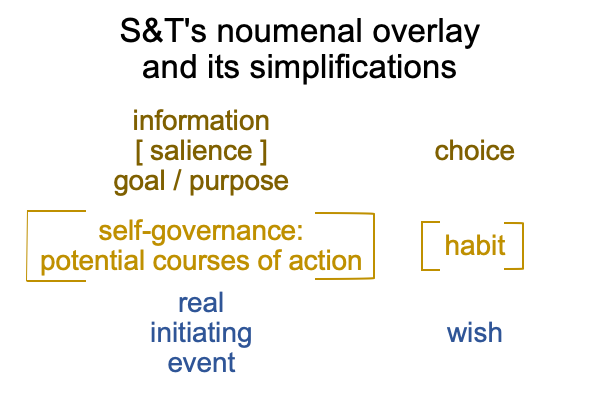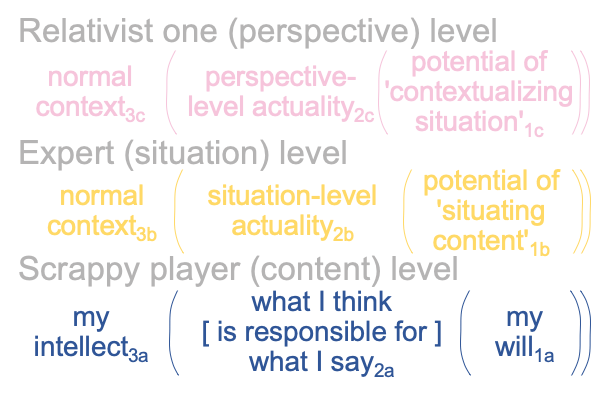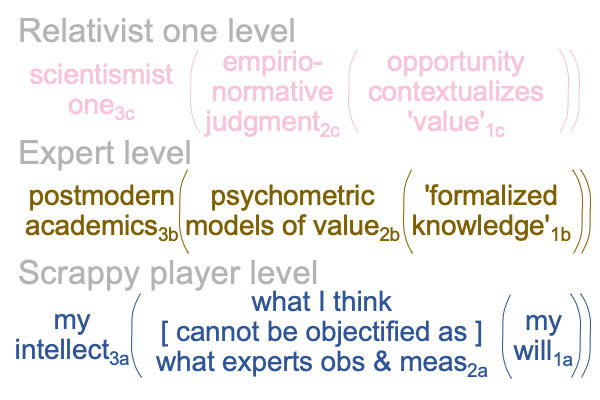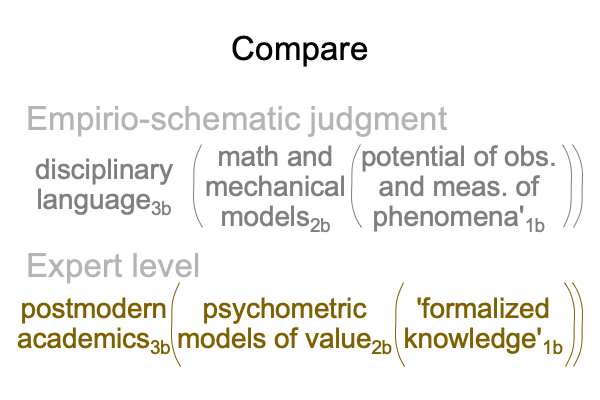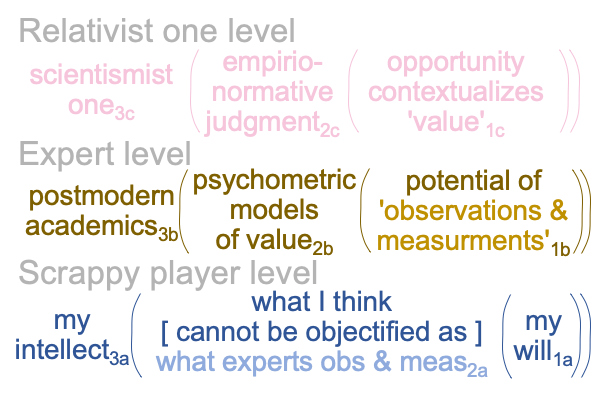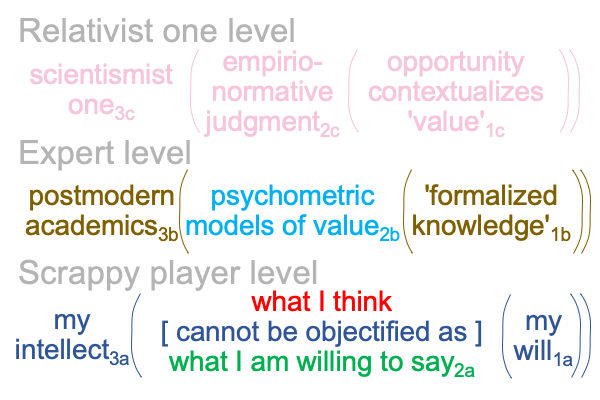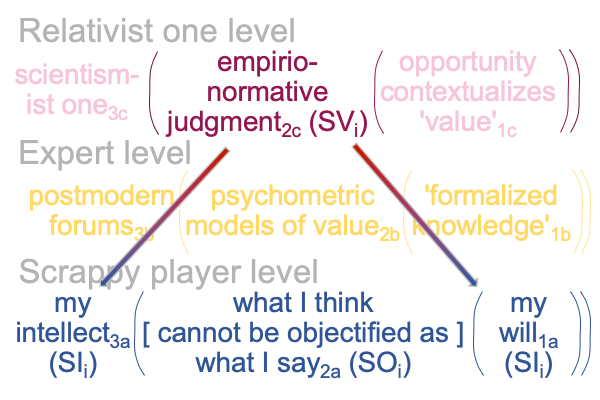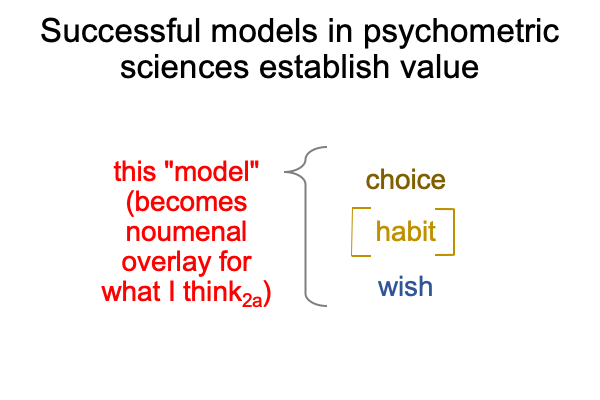Looking at Slavoj Zizek’s Book (2024) “Christian Atheism” (Part 33 of 33)
0339 So, why compare the two interscopes?
Well, there are two Relativist Ones, one belonging to Zizek’s configuration and one contained in the post-truth condition.
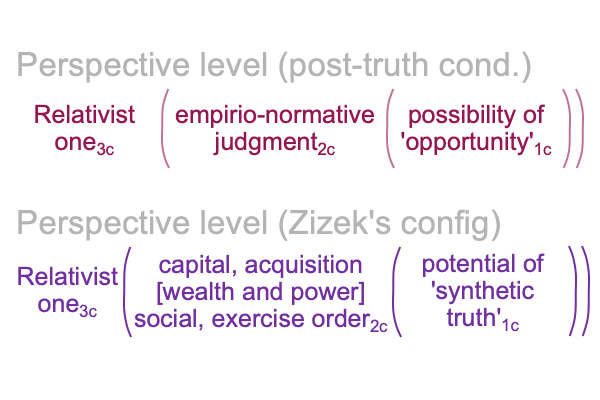
That is a tad confusing.
Plus, it seems to me that the following association of Lacan’s terminology with open slots of the perspective level applies to both interscopes.
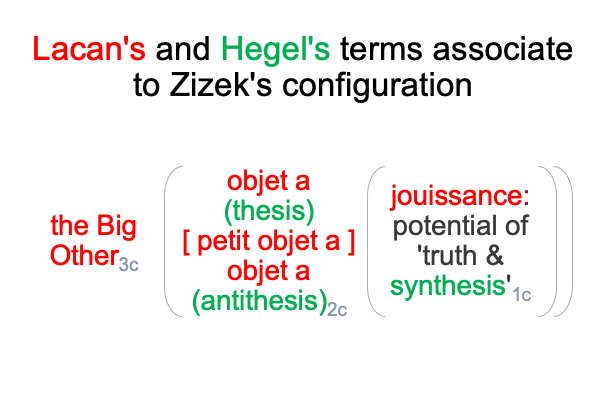
All these items may be regarded as writ small.
Plus, the pattern repeats within Zizek’s interscope. Jouissance1 writ large coincides with the virtual nested form in firstness.
Similarly, objet a2c(2a) writ large matches the actualities2 on the perspectivec and contenta levels. The petit objet a writ large matches the situation-level actuality2b.
Uh, does that also apply to the interscope for the post-truth condition?
If it does, then there are two Relativist Ones3c, one corresponds to a little Big Other3c(2b) (in Zizek’s configuration as a psychometric valuation2b) and one corresponds to a big Big Other3c (for the interscope for the post-truth condition).
0340 Okay, the little Relativist Big Other3c(2b) dwells within the big Relativist Big Other2b.
What about Christian atheism?
Zizek’s configuration resides within the slot for psychometric valuation2b.
Does Zizek’s Christian atheism3c(2b) deny the divinity of the big Big Other3c?
If it does, then the following comparison offers another reason why modern politics is immanently theological and supports Zizek’s concluding chapter, arguing that the post-modern West should not disregard psychoanalysis, simply because it questions postmodern scientific-sounding capitalist and socialist valuations2b.
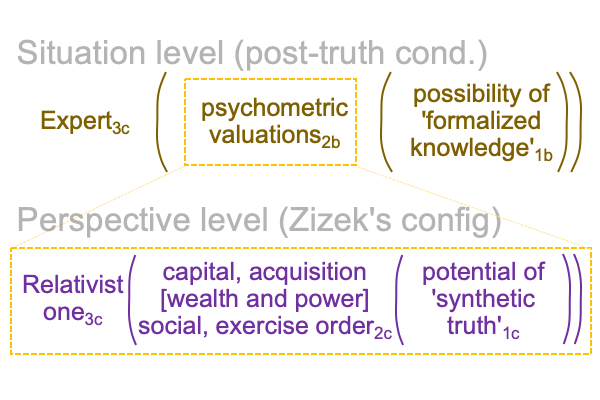
0341 So… uh…. why does Zizek propose Christian atheism3c(2b)?
Isn’t Slavoj Zizek an expert2b operating on the formalized knowledges of Lacanian psychoanalysis, Hegelian philosophy and Marxist materialism1b?
Excuse me while I scribble a note saying, “Of course, he sees the light…”
0342 I want to note, if the big Relativist One3c is divine, as preached by the banquet dinner speaker, Baelzebob Jones,speaking, way back when, to the CPP on the evening when I was conceived, then psychoanalysis should be disregarded, because “wealth” and “power” are two distinct and separate entities2c, just like photons as waves and… um… photons as particles.
“… yeah, the light.”
Photons as particles1b(2b) and photons as waves1b(2b) produce distinct and separate measurements2b(2b), as far quantum-physics apparatuses3b(2b) are concerned. Data1c(2b) is the potential1c(2b) of measurements2b(2b). And, measurements2b(2b) virtually situate a model standing in the place of the noumenon2a(2b).
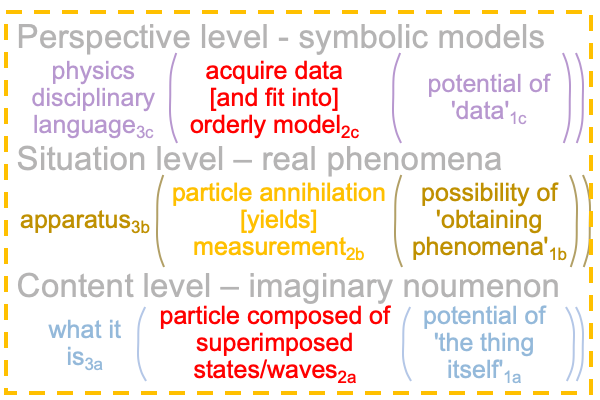
Consequently, an irreconcilable distinction between particle and wave2b constitutes an opportunity1c that supports the divinity of the big Relativist One of the Physics of the Quantum Universe3c.
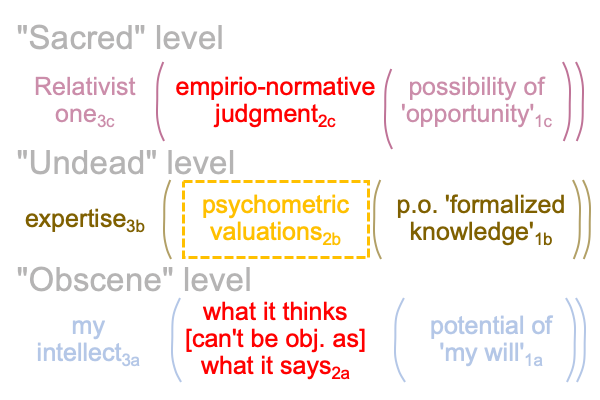
Fortunately, all hell broke loose before Dr. Jones finished his address.
0342 The logics of thirdness are exclusion, complement and alignment. Here the little and the big normal contexts align, but the little cannot replace the big. Nonetheless, the same term is used for both perspective-level normal contexts, even though the two normal contexts differ. Both are Relativist Ones.
0343 The logics of secondness are those of contradiction and non-contradiction. If the two actualities of {capital, acquisition [wealth and power] social, exercise of order}2c(2b) and psychometric valuation2b do not contradict, then I can regard one as an example of the other… or maybe… the little one pays tribute to the big one.
0344 The logics of firstness are inclusion. Firstness allows contradictions. Here, the same principle noted above applies. A synthetic truth1c(2b) supporting a situation-level little Relativist one3c(2b) offers opportunity1c for a perspective-level big Relativist one3c.
In Zizek’s book, a synthetic truth1c(2b) undergirds an intellectual configuration of the dyad, {capital, acquisition [wealth and power] social, exercise of order}2c(2b) for Zizek’s little Relativist One3c(2b). Zizek’s psychometric valuation2b may contextualized as a possible opportunity1c by a post-truth big Relativist One3c.
Surely, opportunity1c is potentiated by the little Relativist one3c(2b).
But, what opportunity1c is potentiated by Christ3c(2b)?
Oh, I must not forget, Zizek calls for psychoanalysis.
So, Christ3c(2b) must be an intervention.
0345 The perspective-level nested form in Zizek’s configuration neatly fits into the slot for psychometric valuations2bon the situation-level of the post-truth interscope.
Does this explain why the names of post-truth levels should be totally juiced up?
0346 Okay, the entire interscope for Zizek’s configuration resides in the slot for psychometric valuations2b for the post-truth interscope.
This remarkable finding adds value to Zizek’s argument.
Zizek’s Christian atheism is designed to challenge current psychometric valuations2b arising from the potential of ‘a postmodern formalization of knowledge’1b within the normal context of a stylistic union of capitalist and socialist expertise3b.
Christian atheism3c(2b) can substitute for the little Relativist One3c(2b).
But, what about the union between the big Relativist One3c and the little Relativist One3c(2b)?
Would some say… “the unholy union”?
0347 See Razie Mah’s blog for February 11, 2023 for that one.
This blog serves as the first exercise for exploring the utility these arguments.
First, associate features of the music video to elements in Zizek’s configuration.
My hint is that the dyad, {money and political influence [pays for] the Body Shop} associates to the imaginary actuality, {raw materials [construct] specified product}2a(2b).
The rest is left to the exercise.
Second, place the first step into the slot for psychometric valuations2b in order to explain why this music video is produced and advertised by American corporate media.
0348 Do the producers and promulgators of this video want to influence what the white woman has to say?
Write your essay and send to raziemah@reagan.com with written permission for publication on Razie Mah’s blog.
0349 This first exercise reveals the comedy of locating Zizek’s configuration in the slot for psychometric valuations in the post-truth condition. It also reveals the tragedy.
Consider the tragic photon.
In order to reveal itself as either a wave or a particle, it must be annihilated.
Is that too high a price to pay?
I guess not, because a photon is neither living nor dead.
0350 Take a look at the preceding interscope.
On the obscene level, no-one cares what the photon thinks, because it is doomed to annihilation in the process of determining whether it “says” that it is a particle or a wave. How obscene is that?
On the undead level, experts in physics3b operate the apparatus3b(2b) that converts what the photon says2a into measurements2b(2b), that support an orderly model2c(2b). The model2c(2b) asserts that the photon will say, “I am a particle composed of superimposed states and waves”2a(2b)“. In other words, the measured photon2b(2b) says what the experts3b predict that it will say.
0351 Does this demonstrate the potential of ‘formalized knowledge’1b?
Formalized knowledge1b makes the annihilation of the subject2b(2b) possible.
The subject2a(2b)‘s content-level autonomy converts into a situation-level measurement2b(2b) that supports a model2c(2b)that offers an opportunity1c for an empirio-normative judgment2c to stand for what people think and say2a concerning the soon-to-be annihilated subject2a(2b).
0352 On the sacred level, the One Physicist2c formulates a judgment2b weighing the intelligibility of what the experts report2b and the universality of what photons are telling the experts2a. This judgment reveals to human reason3a(1a)that it1b does not matter what photons think2a.
Isn’t that obscene?
Indeed, reason3a(1a), defined as “the intellect3a operating on the will1a“, is obscene.
Where the hell is truth1a?
0353 Isn’t that what Zizek is interested in?
Isn’t that what Christian atheism is supposed to deliver?
0354 So concludes my independent approach to what Zizek argues for.
I end with a note on nomenclature.
Lacan is very clever in his terminology.
So is Zizek.
In the following picture on nomenclature, Lacan’s column applies to the entire interscope of Zizek’s configuration and Zizek’s “juiced up” column applies to the entire post-truth interscope.
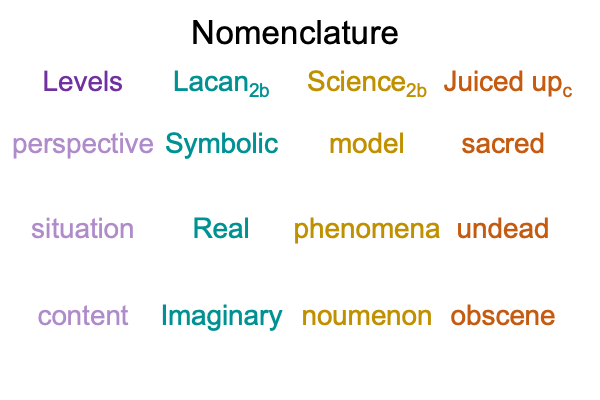
Perhaps, these columns intimate future directions of inquiry during these crazy times, belonging to the Fourth Battle of the Enlightenment Gods.
0355 I thank Slavoj Zizek for a book that is worthy of examination.

